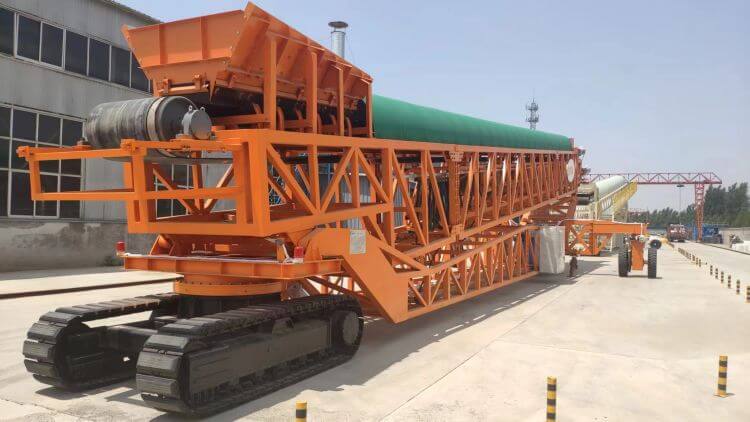stackers serve as core equipment for bulk material handling in industrial operations, primarily used for efficient stockpiling and precise distribution of materials such as ores, coal, and grains. Through automated conveying systems and intelligent control technologies, stackers can transform disordered incoming materials into structurally stable storage formations, increasing storage space utilization by 30%, reducing manual operations by 80%, and ensuring safe operations in high-risk environments. They are widely applied in ports, mining operations, thermal power plants, cement manufacturing, and logistics hubs.

How do stackers achieve scientific material management?
The core functionality of stackers is built upon three-dimensional dynamic operation capabilities. When materials are transported to the boom end via Conveyor Belts, the equipment utilizes 360° horizontal rotation and -5° to +28° pitch adjustment to create stable parabolic trajectories. Taking iron ore stockpiling at ports as an example: the control system automatically adjusts the material discharge angle based on pile height, ensuring each material layer thickness is maintained within 30-50cm. This effectively reduces material segregation, decreasing particle size deviation from traditional methods' 15% to below 3%.
Intelligent upgrades endow the equipment with adaptive adjustment capabilities. Laser scanners construct real-time 3D models of material piles. When detecting localized over-stacking, the PLC control system automatically corrects boom movement parameters with precision comparable to CNC equipment. Zoomry Heavy Industry's ZR-SF series features dynamic compensation systems that maintain ±2cm stacking accuracy even in 6-level wind conditions, increasing yard space utilization to over 85% - approximately 40% higher than traditional methods.
Functional characteristics and application scenarios of main models
telescopic stacker
As a basic model, its core feature lies in the hydraulically-driven telescopic boom. In coal yards of thermal power plants, the equipment's boom can extend up to 45 meters to cover stacking areas and retract to 18 meters for maintenance. Zoomry's quick-assembly modular structure reduces on-site assembly time to 72 hours, improving efficiency by 60% compared to conventional models.
mobile shiploader
mobile shiploaders combine stacking and ship loading processes, equipped with omnidirectional moving chassis and wave compensation devices. During loading operations for 300,000 DWT bulk carriers, their intelligent positioning system achieves ±5cm hatch alignment accuracy with loading efficiency reaching 8,400 TPH - equivalent to processing 350 standard truckloads per hour. Enclosed conveyor channels combined with air curtain dust suppression technology maintain dust concentration below 2mg/m³ in working areas.
truck unloader
Designed for logistics park unloading requirements, this equipment adopts bidirectional processing channels and low-position receiving hoppers. Vibratory feeding modules address material adhesion issues in high-humidity conditions, while automatic weighing systems enable real-time inventory data synchronization.
| Model | Core Technical Parameters | Industry Applications |
|---|---|---|
| Telescopic Stacker | Telescopic ratio 1:2.5, pitch ±28° | Coal yards for power plants |
| Mobile Shiploader | Loading efficiency 8,400TPH, positioning accuracy ±5cm | Bulk cargo ports |
| Truck Unloader | Capacity 1,800TPH, dust concentration ≤5mg/m³ | Logistics hubs |
| All-terrain Stacker | Ground clearance 450mm, climbing ability 15° | Open-pit mining sites |
Technological upgrades of stackers
Stacker innovations consistently focus on three core objectives: enhanced operational capacity, smarter maintenance systems, and greener production environments. Recent years have seen qualitative leaps in equipment performance through the integrated development of materials science and intelligent control technologies.
In mechanical structures, new high-strength alloy materials have revolutionized design concepts. Taking boom structures as an example, Zoomry's telescopic mechanisms using Q690D special steel achieve 18% weight reduction when extended to 60m working radius while withstanding dynamic loads equivalent to 80 passenger cars. This not only extends equipment lifespan but improves stability by 40% in complex terrains.
Drive system innovations are even more groundbreaking. The combination of permanent magnet synchronous motors and intelligent frequency converters acts as "smart hearts" for equipment. Port tests show this system reduces energy consumption to 0.15kWh per ton - 25% more efficient than traditional drives, equivalent to cutting 150 tons of CO₂ emissions annually. Remarkably, the motors maintain over 95% torque output at low speeds, perfectly adapting to various working conditions.
Breakthroughs in intelligent monitoring redefine maintenance standards. Over 200 sensors distributed at critical points function as the equipment's "neural network," continuously collecting data streams like vibration frequency and temperature changes. Through machine learning algorithms, the system can predict bearing failures 300 hours in advance, reducing unexpected downtime by 85% compared to scheduled maintenance.
Heightened environmental requirements drive continuous dust suppression innovations. The latest composite solution combines water mist (10μm droplets) with electrostatic precipitation (15kV): first humidifying dust particles then aggregating residual particulates through electric fields. While maintaining material dryness, this controls worksite PM2.5 below 5μg/m³ - meeting indoor air purification standards.
Scientific decision-making for equipment selection
Choosing suitable models requires evaluating three key dimensions:
Material Characteristics
For highly abrasive materials, tungsten carbide-coated conveyor belts and hopper liners should be selected; explosive dust environments require nitrogen inerting systems and static elimination devices. Zoomry's material laboratory offers free characteristic testing services.
Operational Conditions
Coastal equipment must meet ISO 12944 C5M anti-corrosion standards, while polar regions need -40℃ cold-start kits. Modular designs enable rapid functional module replacement for different scenarios.
Cost Optimization
Select models with 20%-30% capacity headroom to meet peak demands without overinvestment. Lifecycle cost analysis should focus on energy consumption and maintenance cost ratios.
As CE and EAC certified manufacturer, Zoomry provides customized solutions globally. Our engineering team can deliver 3D layout plans and benefit analysis reports within 72 hours based on site surveys. For technical details, contact +86 131-6401-6717.

 ZOOMRY
ZOOMRY

